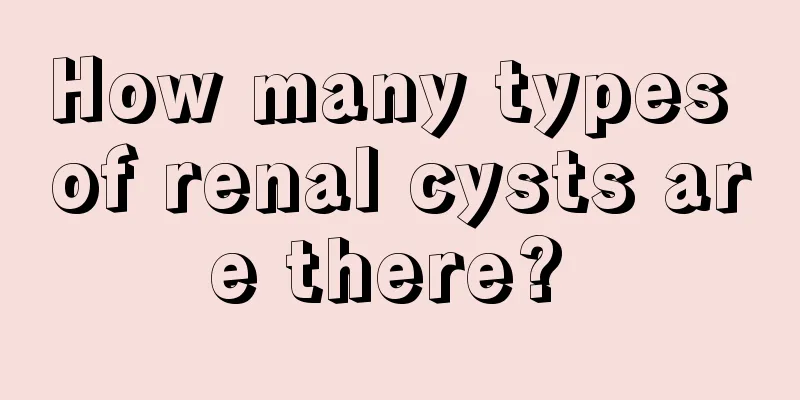How many types of renal cysts are there?

|
Renal cyst is a relatively common kidney disease, especially in the elderly, who are most likely to suffer from renal cysts. There are many types of renal cysts, and all of them have a great impact on patients. Severe cases can easily lead to death. Many patients do not know how many types of renal cysts there are. So, how many types of renal cysts are there? Adult renal cyst It is a congenital hereditary disease. The renal parenchyma is filled with countless round cysts of varying sizes that are not connected to the outside world. The cysts contain fluid. The small ones are invisible to the naked eye, and the large ones can be several centimeters. Therefore, it is called polycystic kidney. Symptoms include increased nocturia, low back pain, high blood pressure, etc. Urinalysis may reveal hematuria and a small amount of proteinuria, which often slowly develops into chronic renal failure. 10% of people have kidney stones and 30% have polycystic liver disease. An experienced doctor can confirm the diagnosis with the help of B-ultrasound and intravenous pyelography. Simple renal cyst It may be a congenital abnormality, with one or both kidneys having one or more round cystic cavities of varying sizes that are not connected to the outside world. Most of them are unilateral, so it is called simple renal cyst. The incidence rate may increase with age. 50% of people over 50 years old can be found in this cyst by B-ultrasound. It can be diagnosed with the help of B-ultrasound and CT. Unique features of simple renal cysts: Simple renal cyst is the most common type of cystic kidney disease in clinical practice. Unlike polycystic kidney disease, this disease is not inherited but acquired. In the past, it was believed to be caused by local ischemia. In recent years, studies have shown that it may develop from renal tubular diverticula. As age increases, the number of distal tubules, collecting tubules, and diverticula increases, so the incidence of simple renal cysts also increases. It is mainly seen in adults, and the incidence rate increases with age. About half of people over 50 years old have at least one cyst. The cysts may be unilateral or bilateral, with one or a few cysts in each kidney. The cyst is generally isolated and spherical. If located in the superficial renal cortex, it may change the shape of the kidney. It may also be located in the deep cortex or medulla. The diameter is 0.5 to 1 cm, or 3 to 8 cm. The cyst wall is thin and transparent, and contains straw-yellow liquid, which is relatively viscous. If there has been inflammation, the cyst wall may thicken, become fibrotic, or even calcify. The cyst is not connected to the renal pelvis and its wall is lined with a single layer of squamous epithelial cells. The disease generally does not cause symptoms and is often discovered accidentally for other purposes or during physical examinations. Occasionally, hematuria, local pain, calyceal obstruction, and secondary infection may occur. In some cases, hypertension may occur due to compression of adjacent blood vessels by the cyst, causing local ischemia and increased renin. At this time, the blood pressure will return to normal after aspiration of the cyst fluid or removal of the cyst, which may occasionally cause polycythemia. The disease does not cause kidney function impairment. The natural course of simple renal cysts is slow. Acquired renal cyst It mainly occurs due to uremia or after dialysis treatment. It has nothing to do with age, but is related to the duration of hemodialysis. The kidneys originally do not have renal cysts. According to literature reports, most patients who have been on dialysis for more than 3 years will develop cysts. There are at least 4 cysts in one of its kidneys, most of which are 2 to 3 centimeters in diameter. Some cysts can become infected or even cancerous, and the diagnosis can be confirmed by ultrasound or CT examination. Through the above introduction, I believe everyone has a detailed understanding of the types of renal cysts. Especially the elderly need to pay special attention to the above three types of renal cysts. If they are not careful, it will cause multiple diseases. Patients with more serious conditions should go to the hospital for surgery immediately. |
<<: Is it better to puncture or operate on a renal cyst?
>>: What are the symptoms of hemorrhagic thrombocytopenia?
Recommend
Benefits of hypoglycemic bitter melon
The problem of high blood sugar can easily cause ...
What are the treatment methods for acupuncture dizziness
Nowadays, more and more people are willing to acc...
Does a bad cervical spine make you sleepy easily?
It is difficult for patients with bad cervical ve...
What causes heel pain
The physical health of middle-aged and elderly pe...
What can I eat to make my breasts bigger?
Breasts are extremely important for women. Not on...
Melanoma epidemiology and staging progress
Melanoma is one of the malignant tumors with the ...
Do hair loss treatments work?
Hair loss is something that happens and is experi...
What are the methods to treat stomach acid?
Gastric acid, also known as hyperacidity, is a co...
Dull pain in the lower left side of the abdomen
If you have pain in the lower left side of your a...
What are the effects and functions of wild chrysanthemum pillow
As the name suggests, wild chrysanthemum is a wil...
Does smoking cause prostate cancer recurrence?
Smoking is a risk factor for many tumors, but it ...
Will the pharyngeal follicles disappear automatically?
In daily life, throat follicles are a relatively ...
What are the symptoms of advanced lung cancer before death? Introduction to the symptoms of advanced lung cancer
Lung cancer is divided into several stages, and t...
Symptoms and manifestations of colic
Colic is a common gastroenterological disease tha...
What should I do if my eyes are congested due to trauma? How should I deal with it?
The structure of the eye is relatively complex an...









